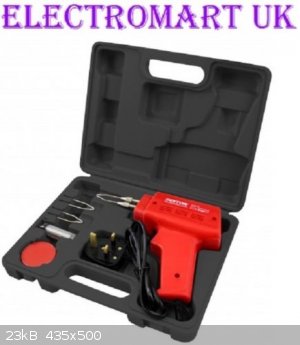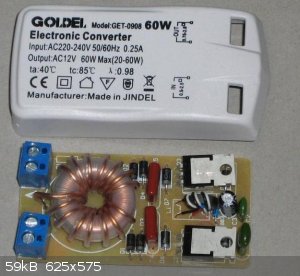Wire loop high current soldering irons
I have a wire loop high current (directly heated) soldering iron. Its good for intermittent use as the tip (wire loop) heats up quickly when switched
on via a finger operated on/off trigger. That also allows manual control of the tip temperature that can be used with a little practice to avoid
overheating the tip which avoids vaporising or carbonizing the flux while allowing full power when contacting thick wires or large solder joints.
Unfortunately with the one I have the transformer heats up quickly and then the increased winding resistance reduces the current though the loop
reducing the heat input for large joint.
See the pic below for an example of a wire loop soldering iron.

In order to simultaneously melt several soldered joints at the same time I made a loop with a broad tip to contact several joints at the same time. I
used the SS strip from an old windscreen wiper blade but it failed to heat up significantly. Apparently my original wire loop is iron but SS has
seven times the specific resistance of iron. So I will need a much thicker SS loop ie seven times the area or 2.6 times its diameter. Curiously SS
has one of the highest ratios between its specific electrical resistance and its thermal resistance which may be usefully. Interesting its electrical
resistance ia about 42 time more than copper.
On a related subject: The soldering iron in the pic above uses a small mains powered transformer with about 7 turns of thick copper wire (about 3mm
dia) to power the loop. The transformer is heavy which makes it cumbersome to use. An obvious solution is to use a direct conversion switch mode
power supply to reduce the the weight. An electronic transformer used to power 12V lamps would be ideal as many have a toroidal transformer which will
simplify rewinding it.
See pic below

PS: thinking about it when using a high frequency electronic transformer the skin depth in iron or magnetic SS may be only a small fraction of the
loop diameter increasing the loop resistance too high. I guess a copper or non magnetic SS would eliminate that problem or even better a SS with a
Curie temperature in the correct range for automatic temperature control. Similar to some Rolls Royce soldering irons. I guess finding the right
material to do that will be difficult.
PSS: Apparently iron nickel copper alloys have curie temperatures from about 500C down to almost room temperature.
See: https://apps.dtic.mil/dtic/tr/fulltext/u2/419216.pdf
[Edited on 5-2-2019 by wg48]
[Edited on 5-2-2019 by wg48]
Borosilicate glass:
Good temperature resistance and good thermal shock resistance but finite.
For normal, standard service typically 200-230°C, for short-term (minutes) service max 400°C
Maximum thermal shock resistance is 160°C
|